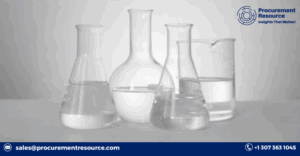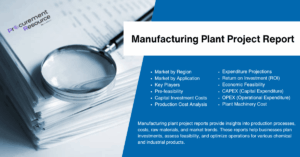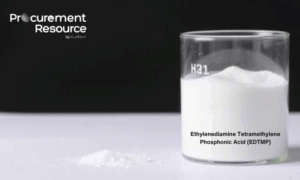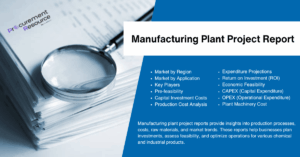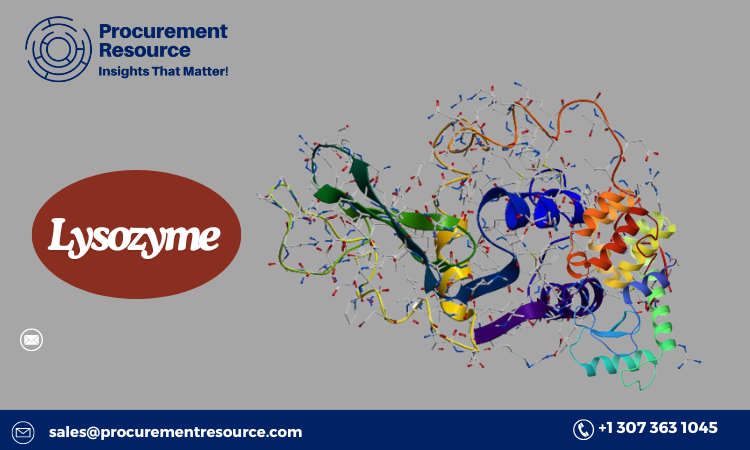
Lysozyme Production Cost Analysis
Lysozyme is an enzyme naturally present in various body fluids, such as saliva, tears, and mucus, and it plays a vital role in the immune system by breaking down bacterial cell walls to prevent infections. This enzyme is extensively utilized in industries like food processing, pharmaceuticals, and biotechnology for its antimicrobial properties. Understanding the costs involved in producing lysozyme is crucial for industry stakeholders, including manufacturers and researchers. This article explores the key factors influencing lysozyme production cost analysis, different production methods, and the economic and market factors affecting its pricing.
Understanding Lysozyme
What is Lysozyme?
Lysozyme is an enzyme that catalyzes the breakdown of polysaccharides in bacterial cell walls, leading to the destruction of bacteria. Discovered by Alexander Fleming in 1922, lysozyme is recognized for its antibacterial properties. Apart from being present in bodily fluids, lysozyme is also found in egg whites, where it serves as a protective agent against bacterial contamination.
Request For Free Sample: https://www.procurementresource.com/production-cost-report-store/lysozyme/request-sample
Applications of Lysozyme
Lysozyme is used in various industries, including:
- Food Industry: It acts as a preservative in foods like cheese and wine to prevent bacterial spoilage.
- Pharmaceuticals: Lysozyme is included in drug formulations for treating infections and preserving biological samples.
- Biotechnology: The enzyme is used in molecular biology for creating bacterial cell lysates, which facilitate the extraction of DNA, RNA, and proteins.
Factors Affecting Lysozyme Production Costs
Several factors contribute to the overall cost of producing lysozyme, including the cost of raw materials, production methods, labor, energy, and market conditions.
1. Raw Material Costs
Raw materials play a significant role in determining the cost of lysozyme production. The main sources of lysozyme are egg whites and genetically engineered microorganisms.
- Egg Whites: Traditionally, lysozyme is extracted from egg whites. The cost of egg whites, influenced by egg prices, significantly impacts the overall production cost. Factors like feed costs, poultry farming practices, and global demand for eggs affect these prices.
- Genetically Engineered Microorganisms: With advancements in biotechnology, lysozyme can now be produced using genetically engineered bacteria or yeast. The cost of these organisms, along with the growth media, chemicals, and nutrients required for fermentation, contributes to the overall production expense.
2. Production Methods
The production method chosen greatly impacts lysozyme production costs. There are two primary methods:
- Extraction from Egg Whites: This traditional method involves isolating and purifying lysozyme from egg whites through processes like homogenization, centrifugation, filtration, and chromatography. Each of these steps incurs costs related to equipment, reagents, and labor.
- Recombinant Production: Recombinant DNA technology allows lysozyme to be produced using genetically modified microorganisms. This process involves inserting the lysozyme gene into a host organism, such as E. coli or yeast, followed by fermentation, expression, and purification of the enzyme. Although the initial setup and development costs are high, recombinant production can be more cost-effective in the long term due to higher yields and scalability.
3. Labor Costs
Labor costs are another crucial factor in lysozyme production. The level of automation, the skill required for various tasks, and regional labor market conditions all influence labor expenses.
- Skilled Labor: Producing lysozyme, especially through recombinant methods, requires skilled professionals with expertise in molecular biology, microbiology, and biochemical engineering. The cost of employing such personnel varies depending on the region and the level of expertise required.
- Automation: Automating the production process can reduce labor costs by minimizing the need for manual intervention. However, the initial investment in automation technology can be substantial.
4. Energy Consumption
Energy usage is a significant factor in lysozyme production, particularly in processes that require heating, cooling, and mechanical operations.
- Extraction Process: Extracting lysozyme from egg whites involves energy-intensive steps like centrifugation, filtration, and chromatography. The cost of electricity and other energy sources needed for these processes contributes to the overall production cost.
- Fermentation: In recombinant production, the fermentation process is energy-intensive, requiring controlled environmental conditions such as temperature and aeration, which consume significant amounts of energy.
5. Equipment and Maintenance Costs
The equipment used in lysozyme production, including fermenters, centrifuges, filtration units, and chromatography systems, represents a significant capital investment.
- Initial Investment: Purchasing and installing production equipment is a major component of the overall production cost. High-quality, durable equipment is essential for maintaining product consistency and quality.
- Maintenance: Regular maintenance of equipment is necessary to ensure optimal performance and prevent downtime. Maintenance costs include spare parts, labor, and any potential production losses during maintenance activities.
6. Purification and Quality Control
Purification of lysozyme is a crucial step in production, ensuring that the final product meets required quality standards.
- Chromatography and Filtration: Purification typically involves techniques like chromatography and filtration, which can be expensive due to the cost of reagents, membranes, and columns. The efficiency of these processes directly impacts yield and production costs.
- Quality Control: Rigorous quality control measures are essential to ensure that the lysozyme produced is free from contaminants and meets regulatory standards. The cost of quality control includes laboratory testing, equipment, and personnel.
7. Regulatory Compliance
Compliance with regulatory standards is essential for lysozyme production, particularly for pharmaceutical and food applications.
- GMP Compliance: Good Manufacturing Practices (GMP) are required for lysozyme used in pharmaceuticals. Compliance with GMP involves additional costs related to documentation, validation, and facility requirements.
- Food Safety Regulations: In the food industry, lysozyme must meet specific safety standards, which may require additional testing and documentation. Compliance with food safety regulations adds to the overall production cost.
8. Market Dynamics
The lysozyme market is influenced by global demand, competition, and pricing strategies.
- Global Demand: Demand for lysozyme is driven by its applications in food, pharmaceuticals, and biotechnology. An increase in demand for natural preservatives, antimicrobial agents, and biotechnological research drives up demand for lysozyme, potentially leading to higher prices.
- Competition: The lysozyme market is competitive, with several manufacturers offering similar products. Competitive pricing strategies, production efficiency, and product differentiation are key factors influencing market prices.
- Supply Chain and Logistics: The cost of transporting raw materials to production facilities and distributing the final product to customers adds to overall production costs. Supply chain disruptions, such as those caused by global events or natural disasters, can lead to price fluctuations.
Recent Trends in Lysozyme Production Costs
In recent years, several factors have influenced the cost of producing lysozyme:
1. Biotechnology Advancements
The development of recombinant DNA technology has had a significant impact on lysozyme production costs. Recombinant production methods have improved yields and reduced reliance on traditional egg white extraction, leading to cost savings over time. Additionally, advancements in fermentation technology and purification processes have further enhanced production efficiency.
2. Rising Demand for Natural Preservatives
There has been a growing demand for natural preservatives in the food industry due to consumer preferences for clean-label products. As a natural antimicrobial agent, lysozyme has seen increased demand, leading to higher production volumes and potentially lower costs per unit due to economies of scale.
3. Impact of the COVID-19 Pandemic
The COVID-19 pandemic disrupted global supply chains, leading to raw material shortages and increased transportation costs. These disruptions have impacted lysozyme production costs, particularly for manufacturers relying on imported raw materials. Additionally, increased demand for antimicrobial agents during the pandemic has driven up lysozyme demand.
4. Environmental and Sustainability Considerations
Sustainability is becoming increasingly important in the biotechnology industry, leading to investments in environmentally friendly processes and renewable raw materials. While these practices may initially increase production costs, they are likely to result in long-term benefits through reduced environmental impact and improved market positioning.
Future Outlook for Lysozyme Production Costs
Looking ahead, several factors are expected to influence the cost of producing lysozyme:
1. Continued Technological Advancements
Ongoing advancements in biotechnology, particularly in gene editing, synthetic biology, and process automation, are expected to further reduce the cost of lysozyme production. These technologies have the potential to increase yields, reduce energy consumption, and streamline purification processes, leading to lower costs.
2. Regulatory Developments
Changes in regulatory requirements, particularly in the food and pharmaceutical industries, could impact lysozyme production costs. Stricter regulations may require additional testing, documentation, and quality control measures, increasing costs. Conversely, regulatory harmonization and the adoption of international standards could reduce compliance costs.
3. Expanding Market Demand
The global market for lysozyme is expected to grow, driven by increasing demand for natural antimicrobial agents in food and pharmaceuticals. Market expansion into emerging economies could lead to increased production volumes and economies of scale, potentially reducing costs.
4. Sustainability Initiatives
Sustainability will continue to be a key focus in the biotechnology industry. Manufacturers are likely to invest in sustainable production practices, such as the use of renewable raw materials and energy-efficient processes, to reduce their environmental footprint and align with consumer preferences for eco-friendly products.
Contact Us:
Company Name: Procurement Resource
Contact Person: Leo Frank
Email: sales@procurementresource.com
Toll-Free Number: USA & Canada — Phone no: +1 307 363 1045 | UK — Phone no: +44 7537 132103 | Asia-Pacific (APAC) — Phone no: +91 1203185500
Address: 30 North Gould Street, Sheridan, WY 82801, USA


